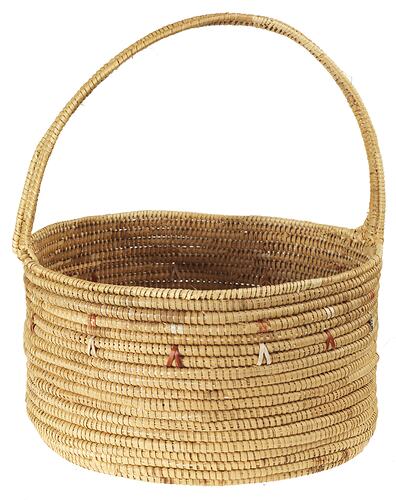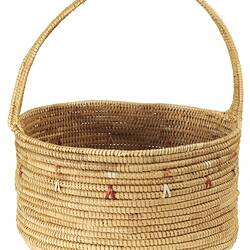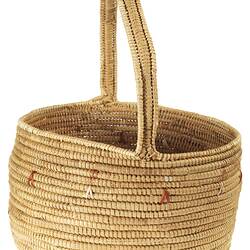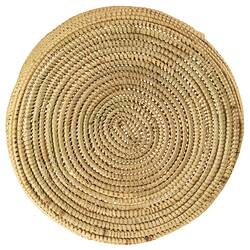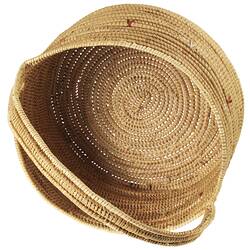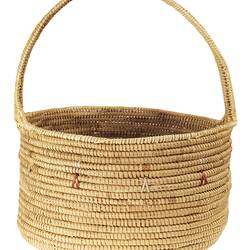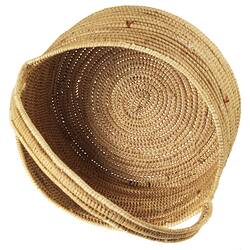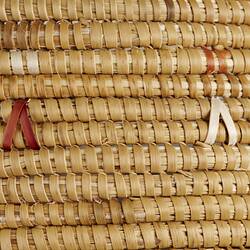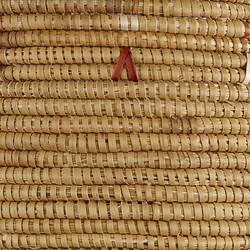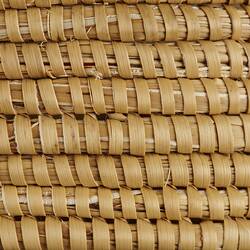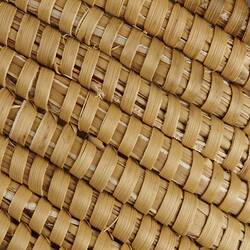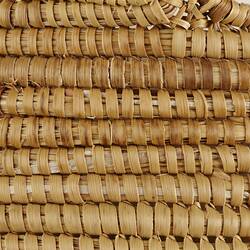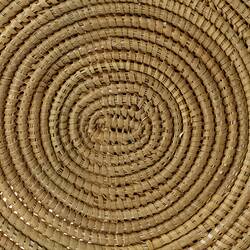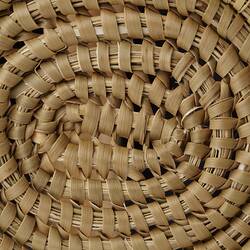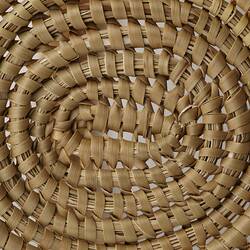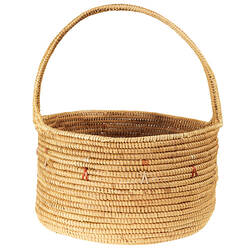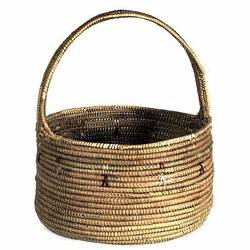Summary
Physical (Object) Description (What materials it is made from, first person voice)
Coiled basket with circular base and a handle. Made using bundle-coil technique from spear grass or sedge, Carex tereticaulis, called poong'ort. Pattern of single row of red and inverted 'V' stitches located mid-way along side; above this a single row of two straight stitches in red fibre.
Pre-contact, Koorie women of Southeastern Australia practiced the coiled basketry technique, making a range of small and large baskets and other material culture. Teaching techniques and skills to the next generation was, and is, an important part of maintaining cultural knowledge and traditions. It is achieved through both active teaching and observation.
Leaves and grasses are collected and processed by the makers using traditional knowledge practices. Spiny headed mat rush, common reed and puung'ort (spear grass) are most commonly used. The leaves are split, gathered in bundles and soaked to make the fibres pliable for weaving. Carry baskets for food and other items, headbands and clothing, and fibre bags for straining food were also woven by the Gunditjmara.
Although Gunditjmara women had been weaving baskets for countless generations, these craftswomen often adapted their style to suit the desires of the European women who were buying them in the colonial period. Decorative elements and stitches to incorporate features of European basketry, such as fixed handles, were added. Basket making became an important part of economic life for Aboriginal women on and off the missions, as the well-made baskets were popular with European women.
Local Name
Ngarrapan
Physical Description
Coiled basket with circular base and a handle. Made using bundle-coil technique from spear grass or sedge, Carex tereticaulis, called poong'ort. Pattern of single row of red and inverted 'V' stitches located mid-way along side; above this a single row of two straight stitches in red fibre.
Significance
'No-one taught me to make my baskets. I used to watch my mother do it and when she put her basket down and went outside, I'd pick it up and do some stitches. When I heard her coming back, I would shove it away real quick and run away. I was a great one for sitting amongst the old people because I knew I was learning something just by watching them. My mum told me we were coming into the white people's way of living. So she wouldn't teach us. That is why we lost a lot of culture. But I tricked her and I watched those old people and I sneaked in a stitch or two.
I never really made a basket until Mum died. I must have been nearly up in my forties. But I came up to look after her and I'd walk up the road and see the grass, and then I remembered the stitch - I tried it, and after she died I took it up. All those years, I never made a basket, but I knew how to do the stitch. I knew the grass.' - Aunty Connie Hart, 1991.
More Information
-
Object/Medium
Basket
-
Maker
-
Cultural Groups
-
Locality
-
Date Produced
-
Object Measurements
255 mm (Length), 255 mm (Width), 290 mm (Height)
-
Classification
-
Date Made
-
Maker
-
Clan/Language Group
-
Place Made
-
Indigenous Region
-
Keywords
-
Type of item
-
Discipline
-
Category
-
Collecting Areas
